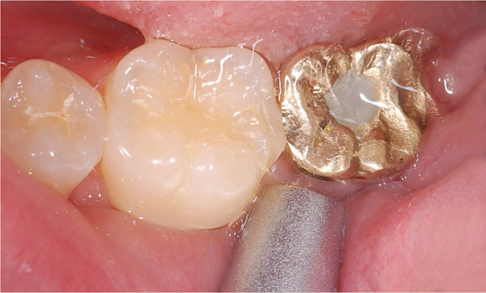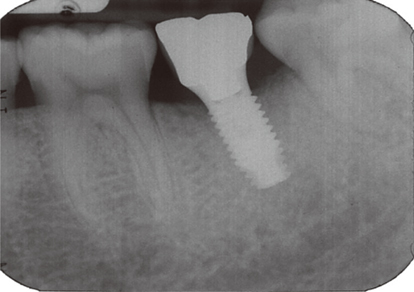J Adv Prosthodont.
2013 May;5(2):172-178. 10.4047/jap.2013.5.2.172.
Evaluation on the efficacy and safety of calcium metaphosphate coated fixture
- Affiliations
-
- 1Department of Prosthodontics, College of Dentistry, Dankook University, Cheonan, Republic of Korea. cho8511@dankook.ac.kr
- 2Department of Oral and Maxillofacial Surgery, College of Dentistry, Dankook University, Cheonan, Republic of Korea.
- 3Dankook University Dental Hospital, Cheonan, Republic of Korea.
- KMID: 2284758
- DOI: http://doi.org/10.4047/jap.2013.5.2.172
Abstract
- PURPOSE
The purpose of this study was to assess the difference in efficacy between calcium metaphosphate (CMP)-coated implant fixtures and conventional resorbable blasted media (RBM) processed implant fixtures.
MATERIALS AND METHODS
This study targeted 50 implants from 44 patients who visited Dankook University Dental Hospital. Implantations were done separately for RBM treated and CMP-coated implants, although their design was the same. Calcium metaphosphate has a quicker biodegradation process through hydrolysis compared to other phosphate calcium groups. For the first year of the implantation, the resorption volume of marginal bone analyzed via radiography and perio-test value were measured, under the check plan. Their analyses were composed of a non-inferiority trials test. A 95% level of reliability was used.
RESULTS
In the comparative analysis of the resorption volume of marginal bone and the perio-test value, no statistically significant difference was found between the CMP-coated implants and RBM implants.
CONCLUSION
One year after the implant placement, CMP-coated implants were found not to be inferior to the conventional RBM implants.
MeSH Terms
Figure
Reference
-
1. Albrektsson T, Sennerby L. State of the art in oral implants. J Clin Periodontol. 1991; 18:474–481.2. Eckert SE, Parein A, Myshin HL, Padilla JL. Validation of dental implant systems through a review of literature supplied by system manufacturers. J Prosthet Dent. 1997; 77:271–279.3. Albrektsson T, Brånemark PI, Hansson HA, Lindström J. Osseointegrated titanium implants. Requirements for ensuring a long-lasting, direct bone-to-implant anchorage in man. Acta Orthop Scand. 1981; 52:155–170.4. Carlsson L, Röstlund T, Albrektsson B, Albrektsson T. Removal torques for polished and rough titanium implants. Int J Oral Maxillofac Implants. 1988; 3:21–24.5. Shin HS, Kim YS, Shin SW. Effects of various surface treatments for titanium on surface micro roughness, static wettability, fibronectin adsorption. J Korean Acad Prosthodont. 2006; 44:443–454.6. Chen J, Tong W, Cao Y, Feng J, Zhang X. Effect of atmosphere on phase transformation in plasma-sprayed hydroxyapatite coatings during heat treatment. J Biomed Mater Res. 1997; 34:15–20.7. Block MS, Kent JN, Kay JF. Evaluation of hydroxylapatite-coated titanium dental implants in dogs. J Oral Maxillofac Surg. 1987; 45:601–607.8. Darimont GL, Cloots R, Heinen E, Seidel L, Legrand R. In vivo behaviour of hydroxyapatite coatings on titanium implants: a quantitative study in the rabbit. Biomaterials. 2002; 23:2569–2575.9. Yamashita K, Kanazawa T. Materials Science Monographs: Inorganic phosphate materials. Tokyo: Elsevier;1989. p. 221–246.10. Lee YM, Seol YJ, Lim YT, Kim S, Han SB, Rhyu IC, Baek SH, Heo SJ, Choi JY, Klokkevold PR, Chung CP. Tissue-engineered growth of bone by marrow cell transplantation using porous calcium metaphosphate matrices. J Biomed Mater Res. 2001; 54:216–223.11. Park EK, Lee YE, Choi JY, Oh SH, Shin HI, Kim KH, Kim SY, Kim S. Cellular biocompatibility and stimulatory effects of calcium metaphosphate on osteoblastic differentiation of human bone marrow-derived stromal cells. Biomaterials. 2004; 25:3403–3411.12. You CK, Yeo IS, Kim MD, Eom TK, Lee JY, Kim SK. Characterization and in vivo evaluation of calcium phosphate coated cp-titanium by dip-spin method. Curr Appl Phys. 2005; 5:501–506.13. Yeo IS, Han JS, Yang JH. Biomechanical and histomorphometric study of dental implants with different surface characteristics. J Biomed Mater Res B Appl Biomater. 2008; 87:303–311.14. The Korean academy of oral and maxillofacial implantology. Atlas of implant terminology. 1st ed. Seoul: Deahan Publishing;2003. p. 15–16.15. Kim YK, Park HS, Jung SM. Implant problem solution. Vol 2: Surgery and Prosthetic problem solution. 1st ed. Seoul: Deahan Publishing;2003. p. 9–10.16. Roos J, Sennerby L, Lekholm U, Jemt T, Gröndahl K, Albrektsson T. A qualitative and quantitative method for evaluating implant success: a 5-year retrospective analysis of the Brånemark implant. Int J Oral Maxillofac Implants. 1997; 12:504–514.17. Buser D, Weber HP, Lang NP. Tissue integration of non-submerged implants. 1-year results of a prospective study with 100 ITI hollow-cylinder and hollow-screw implants. Clin Oral Implants Res. 1990; 1:33–40.18. Buser D, Mericske-Stern R, Bernard JP, Behneke A, Behneke N, Hirt HP, Belser UC, Lang NP. Long-term evaluation of non-submerged ITI implants. Part 1: 8-year life table analysis of a prospective multi-center study with 2359 implants. Clin Oral Implants Res. 1997; 8:161–172.19. Albrektsson T, Zarb G, Worthington P, Eriksson AR. The long-term efficacy of currently used dental implants: a review and proposed criteria of success. Int J Oral Maxillofac Implants. 1986; 1:11–25.20. Buser D, Brägger U, Lang NP, Nyman S. Regeneration and enlargement of jaw bone using guided tissue regeneration. Clin Oral Implants Res. 1990; 1:22–32.21. Noack N, Willer J, Hoffmann J. Long-term results after placement of dental implants: longitudinal study of 1,964 implants over 16 years. Int J Oral Maxillofac Implants. 1999; 14:748–755.22. Roos J, Sennerby L, Lekholm U, Jemt T, Gröndahl K, Albrektsson T. A qualitative and quantitative method for evaluating implant success: a 5-year retrospective analysis of the Brånemark implant. Int J Oral Maxillofac Implants. 1997; 12:504–514.23. Brånemark PI, Zarb GA, Albrektsson T. Tissue-integrated prostheses: Osseointegration in clinical dentistry. In : Lekholm U, Zarb GA, editors. Patient selection. Chicago: Quintessence;1985. p. 199–209.24. Sekine H, Komiyama Y, Hotta H, Yoshida K. Mobility characteristics and tactile sensitivity of osseointegrated fixture-supporting systems. In : Van Steeberghe D, editor. Tissue intergration in oral maxillofacial reconstruction. Amsterdam: Elsevier;1986. p. 236–332.25. Mombelli A, van Oosten MA, Schurch E Jr, Land NP. The microbiota associated with successful or failing osseointegrated titanium implants. Oral Microbiol Immunol. 1987; 2:145–151.26. Curtis DA, Sharma A, Finzen FC, Kao RT. Occlusal considerations for implant restorations in the partially edentulous patient. J Calif Dent Assoc. 2000; 28:771–779.27. Weinberg LA. Reduction of implant loading with therapeutic biomechanics. Implant Dent. 1998; 7:277–285.28. Schulte W, d'Hoedt B, Lukas D, Maunz M, Steppeler M. Periotest for measuring periodontal characteristics--correlation with periodontal bone loss. J Periodontal Res. 1992; 27:184–190.29. Faulkner MG, Giannitsios D, Lipsett AW, Wolfaardt JF. The use and abuse of the Periotest for 2-piece implant/abutment systems. Int J Oral Maxillofac Implants. 2001; 16:486–494.30. Wyatt CC, Zarb GA. Bone level changes proximal to oral implants supporting fixed partial prostheses. Clin Oral Implants Res. 2002; 13:162–168.31. Schwartz-Arad D, Yaniv Y, Levin L, Kaffe I. A radiographic evaluation of cervical bone loss associated with immediate and delayed implants placed for fixed restorations in edentulous jaws. J Periodontol. 2004; 75:652–657.
- Full Text Links
- Actions
-
Cited
- CITED
-
- Close
- Share
- Similar articles
-
- Comparative Study on Osseointegration of Calcium Metaphosphate (CMP) Coated Implant to RBM Implant in the Femur of Rabbits
- In Vitro Bone Formation by Osteoblasts in Calcium Metaphosphate and Highly Purified Bovine Xenograft (Lubboc(R))
- CLINICAL STUDY OF ENDOSSEOUS HYDROXYAPATITE COATED IMPLANTS
- Effect of Various Inodizing Characteristics on Bone Integration of Titanium Implant Surface Design
- The effect of fibronectin-coated implant on canine osseointegration



